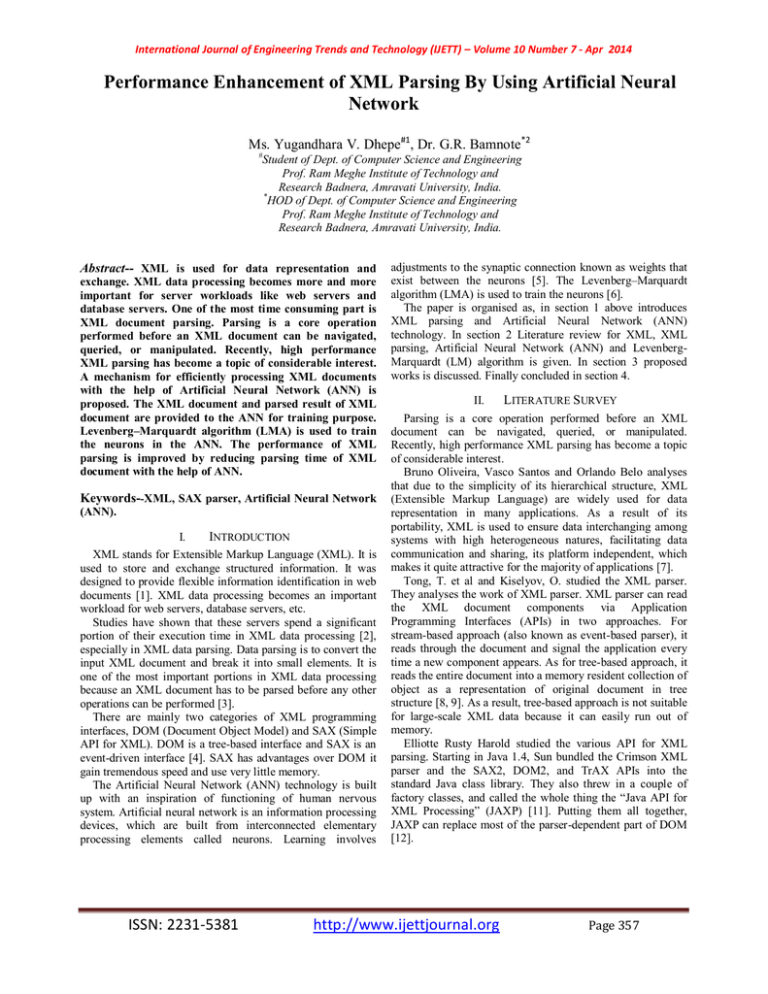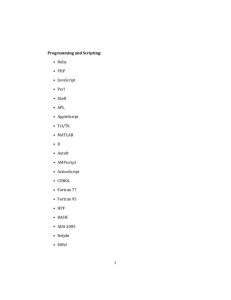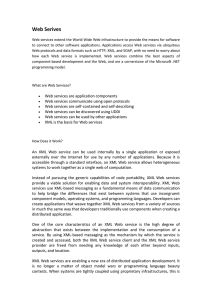Performance Enhancement of XML Parsing By Using Artificial Neural Network
advertisement

International Journal of Engineering Trends and Technology (IJETT) – Volume 10 Number 7 - Apr 2014
Performance Enhancement of XML Parsing By Using Artificial Neural
Network
Ms. Yugandhara V. Dhepe#1, Dr. G.R. Bamnote*2
#
Student of Dept. of Computer Science and Engineering
Prof. Ram Meghe Institute of Technology and
Research Badnera, Amravati University, India.
*
HOD of Dept. of Computer Science and Engineering
Prof. Ram Meghe Institute of Technology and
Research Badnera, Amravati University, India.
Abstract-- XML is used for data representation and
exchange. XML data processing becomes more and more
important for server workloads like web servers and
database servers. One of the most time consuming part is
XML document parsing. Parsing is a core operation
performed before an XML document can be navigated,
queried, or manipulated. Recently, high performance
XML parsing has become a topic of considerable interest.
A mechanism for efficiently processing XML documents
with the help of Artificial Neural Network (ANN) is
proposed. The XML document and parsed result of XML
document are provided to the ANN for training purpose.
Levenberg–Marquardt algorithm (LMA) is used to train
the neurons in the ANN. The performance of XML
parsing is improved by reducing parsing time of XML
document with the help of ANN.
Keywords--XML, SAX parser, Artificial Neural Network
(ANN).
I.
INTRODUCTION
XML stands for Extensible Markup Language (XML). It is
used to store and exchange structured information. It was
designed to provide flexible information identification in web
documents [1]. XML data processing becomes an important
workload for web servers, database servers, etc.
Studies have shown that these servers spend a significant
portion of their execution time in XML data processing [2],
especially in XML data parsing. Data parsing is to convert the
input XML document and break it into small elements. It is
one of the most important portions in XML data processing
because an XML document has to be parsed before any other
operations can be performed [3].
There are mainly two categories of XML programming
interfaces, DOM (Document Object Model) and SAX (Simple
API for XML). DOM is a tree-based interface and SAX is an
event-driven interface [4]. SAX has advantages over DOM it
gain tremendous speed and use very little memory.
The Artificial Neural Network (ANN) technology is built
up with an inspiration of functioning of human nervous
system. Artificial neural network is an information processing
devices, which are built from interconnected elementary
processing elements called neurons. Learning involves
ISSN: 2231-5381
adjustments to the synaptic connection known as weights that
exist between the neurons [5]. The Levenberg–Marquardt
algorithm (LMA) is used to train the neurons [6].
The paper is organised as, in section 1 above introduces
XML parsing and Artificial Neural Network (ANN)
technology. In section 2 Literature review for XML, XML
parsing, Artificial Neural Network (ANN) and LevenbergMarquardt (LM) algorithm is given. In section 3 proposed
works is discussed. Finally concluded in section 4.
II.
LITERATURE SURVEY
Parsing is a core operation performed before an XML
document can be navigated, queried, or manipulated.
Recently, high performance XML parsing has become a topic
of considerable interest.
Bruno Oliveira, Vasco Santos and Orlando Belo analyses
that due to the simplicity of its hierarchical structure, XML
(Extensible Markup Language) are widely used for data
representation in many applications. As a result of its
portability, XML is used to ensure data interchanging among
systems with high heterogeneous natures, facilitating data
communication and sharing, its platform independent, which
makes it quite attractive for the majority of applications [7].
Tong, T. et al and Kiselyov, O. studied the XML parser.
They analyses the work of XML parser. XML parser can read
the XML document components via Application
Programming Interfaces (APIs) in two approaches. For
stream-based approach (also known as event-based parser), it
reads through the document and signal the application every
time a new component appears. As for tree-based approach, it
reads the entire document into a memory resident collection of
object as a representation of original document in tree
structure [8, 9]. As a result, tree-based approach is not suitable
for large-scale XML data because it can easily run out of
memory.
Elliotte Rusty Harold studied the various API for XML
parsing. Starting in Java 1.4, Sun bundled the Crimson XML
parser and the SAX2, DOM2, and TrAX APIs into the
standard Java class library. They also threw in a couple of
factory classes, and called the whole thing the “Java API for
XML Processing” (JAXP) [11]. Putting them all together,
JAXP can replace most of the parser-dependent part of DOM
[12].
http://www.ijettjournal.org
Page 357
International Journal of Engineering Trends and Technology (IJETT) – Volume 10 Number 7 - Apr 2014
Pranob K Charles, Dr. H.Khan ,Ch.Rajesh Kumar
,N.Nikhita Santhosh Roy ,V.Harish ,M.Swathi analyses
Artificial Neural Network. Artificial Neural Network is the
simple clustering of the primitive artificial neurons. This
clustering occurs by creating layers, which are then connected
to one another. There are usually a number of hidden layers
between these two layers. When the input layer receives the
input its neurons produce output, which becomes input to the
other layers of the system. The process continues until a
certain condition is satisfied or until layer is invoked and fires
their output to the external environment [5].
A.Saravanan, Dr.P.Nagarajan analyses the various types of
training algorithms for which the Multilayer Perception
(MLP) Network learn exist. This depends on many factors
including the number of weights and biases, error goal and
number of training iterations (epochs). Back propagation
algorithm, the common and most widely used algorithm in
training Artificial Neural Network learns by calculating an
error between desired and actual output and propagate the
error information back to each node in the network. In this
study, two training algorithms are evaluated for the different
dataset allocations into training, validation and testing. They
are: Levenberg-Marquardt and Quasi-Newton [6].
Amir Abolfazl Suratgar, Mohammad Bagher Tavakoli, and
Abbas Hoseinabadi analyses the Error Back Propagation
(EBP) algorithm. The Error Back Propagation (EBP)
algorithm has been a signification improvement in neural
network research, but it has a weak convergence rate. Many
efforts have been made to speed up EBP algorithm. All of
these methods lead to little acceptable results. The LevenbergMarquardt (LM) algorithm ensued from development of EBP
algorithm dependent methods [13].
appearance of a processing instruction. The Parser Factory
object creates a framework around the parser of your choice.
It parses the document, calling on the Document Handler,
Entity Resolver, DTD Handler, and Error Handler interfaces
as necessary [16].
In Java, an interface is a collection of routines, or methods
in a class. The document-handler interface is where you put
the code for your program. Within the document handler, you
must implement methods to handle elements, attributes, and
all the other events that come from parsing an XML document
[7].
C. Training Algorithms
Various types of training algorithms for which the
multilayer perception (MLP) network learn exist but it is very
difficult to know which training algorithm will be suitable for
training ANN model. This depends on many factors including
the number of weights and biases, error goal and number of
training iterations (epochs). There are two training algorithms
for the different dataset allocations into training, validation
and testing. They are: Levenberg-Marquardt and QuasiNewton.
D. Levenberg-Marquardt Artificial Neural Networks
In an ANN, each neuron will typically apply an activation
function to a weighted sum of inputs and provide a single
output. Such a training process can be performed by one of a
number of algorithms, the most popular being back
propagation [17], but LM and Conjugate Gradient Descent
[18] are also in common use.
III. PROPOSED WORK
A. Parsing Process
Parsing is the process of reading a document and dissecting
it into its elements and attributes, which can then be analyzed.
In XML, parsing is done by an XML processor, the most
fundamental building block of a Web application [14]. All
modern browsers have a built-in XML parser. An XML parser
converts an XML document into an XML SAX object, which
can then be manipulated with a JavaScript [10]. As the
document is parsed, the data in the document becomes
available to the application using the parser. The XML
processor parses and generates an XML document. The
application uses an API to access objects that represent part of
the XML document [15].
B. SAX Parser
As each event occurs, the program calls the appropriate
event handler. The event handlers work like the functions of a
graphical interface, which is also event-driven in that one
function handles a mouse click in one button, another handles
a key press, and so on. In the case of SAX, each event handler
processes an event such as the beginning of an element or the
ISSN: 2231-5381
Fig. 1: Example of an MLP ANN with a single output
An example MLP network with 11 input neurons, four
hidden neurons and two output neurons is shown in Fig. 1. In
the general case, for M input neurons im, P hidden neurons hp
and one output neuron o, the weights on the edges between the
input and hidden layers can be represented by Wpm and those
between the hidden and output layer (assuming a single output
neuron) by wp. Given k input vectors, input value m is given
the value when presented with vector γ where γ= {1,2,…,k}.
mi.
http://www.ijettjournal.org
Page 358
International Journal of Engineering Trends and Technology (IJETT) – Volume 10 Number 7 - Apr 2014
The LM algorithm has recently become increasingly
popular as its second-order optimization techniques allow a
very efficient batch update method. A drawback of the LM
approach is that the ANN must have only a single output, but
this can be overcome by implementing multiple networks
[19]. For the detailed mathematics underlying the LM
algorithm, Marquardt [20], but general LM algorithm is
shown in Fig. 2 and is briefly explained below.
Where v = MP + 2P and w is a vector of weights w =
[W11 ,.., WPM, B1, .. ,BP, w1,..,wP ]T, where the Bp values
are the bias values of the hidden neurons. To update the
weights during training the LM algorithm determines a weight
update vector Δw, calculated by
Where e is the vector containing errors for each input
vector in the batch and I is the identity matrix of dimension v.
The new weights can now be calculated by
Fig. 2: Flow diagram outlining the procedure for using the LevenbergMarquardt training algorithm.
Each batch of data is fed forward through the network, as
described previously, to obtain a vector of output values each
calculated using equation (1) below, where z is the activation
function.
The least mean-square (LMS) error can then be obtained
using
Where Rγ is the desired output from the ANN for a specific
input vector γ. The Jacobian matrix used in LM requires a
vector of all the weights contained within the network to
calculate a matrix of partial derivatives (with respect to each
weight individually) for each input pattern in the batch. The
Jacobian is given by
ISSN: 2231-5381
The ANN’s LMS error with new weights is now
computed. If the new error is smaller than the previous error
then µ is reduced by a factor µ-, but if the error is larger than
the previous error u is increased by a factor of µ+. The values
of µ, µ- and µ+ are all training parameters that must be
selected before training the network [21].
IV. EXPERIMENTAL RESULTS
In this work, XML documents are the input to the system.
We have used SAX parser & Artificial Neural Network. In
implementation, we have implemented parsing with neural
network using the java language.
In proposed design after running the MainXML.java code.
With the help of ANN it building network layer after that
network is trained, output of trained network available at
xmls/output.xml. It also shows the time needed for ANN
training in ms. we have to provide the new XML document to
the system for comparing time needed to parse XML
document by SAX parser and ANN. The system also asks for
which tag to read.
After parsing we compare time taken to parse XML
document by SAX parser and ANN. Then SAX parser which
is used Artificial Neural Network (ANN) required less time
for parsing the XML document than simple SAX parser.
http://www.ijettjournal.org
Page 359
International Journal of Engineering Trends and Technology (IJETT) – Volume 10 Number 7 - Apr 2014
TABLE I
RESULTS OF EXPERIMENTATION
Sr. No.
Name of
XML
documents
Size in
Kb
(Kb)
1
2
3
4
5
6
7
8
9
gadget1
gadget2
cd_catlog
com
save
emp1
pre
artifacts
overrides
1
2
5
6
30
60
90
96
287
Total Time
Needed by
normal
parser i.e.
SAX
parser
(ms)
336
355
3386
1269
6487
35313
22382
34321
146147
Time
required to
parse by
NN XML
Parser
(ms)
1025
698
717
847
761
829
793
880
1139
V.
CONCLUSION
The mechanism is used in this paper for efficiently
processing XML documents. Provide set of XML document to
SAX parser as an input, parsing results is stored in the
database and calculate the time required to parse the set of
XML document. Providing the same set of XML document to
the SAX parser which is used Artificial Neural Network
(ANN) and also calculate the time required to parse the set of
XML document. If time required for parsing the set of XML
document to SAX parser and SAX which is used Artificial
Neural Network (ANN) is compared. Then SAX parser which
is used Artificial Neural Network (ANN) required less time
for parsing the set of XML document than simple SAX parser.
This proposed system improves the performance of XML
parsing by reducing parsing time of set of XML document
with the help of Artificial Neural Network (ANN).
ACKNOWLEDGMENT
First of all my sincere thanks go to my college Prof. Ram
Meghe Institute of Technology & Research, Badnera for
offering me the platform and required environment needed to
develop the idea. I would like to express my sincere gratitude
to my project guide and Head of the Department of Computer
Sc. & Engg. Dr. G.R. Bamnote for the continuous support,
for his patience, motivation, enthusiasm, and immense
knowledge. His guidance helped me in all the time of
research.
REFERENCES
[1] W3C, “EXTENSIBLE MARKUP LANGUAGE (XML).” [ONLINE]. AVAILABLE:
HTTP://WWW.W 3.ORG/XML.
[2] W3C, “Document object model (DOM) level 2 core specification.”
[Online]. Available: http://www.w3.org/TR/DOM-Level-2-Core.
[3] Fangju Wang, Jing Li, Hooman Homayounfar, “A space efficient XML
DOM parser” in Journal of Data & Knowledge Engineering,Volume 60,
Issue 1, January 2007, Pages 185-207.
ISSN: 2231-5381
[4] Chengkai Li, “XML Parsing, SAX/DOM”. Department of Computer
Science and Engineering,
University of Texas at Arlington.
[5] Pranob K Charles, Dr. H.Khan, Ch.Rajesh Kumar, N.Nikhita Santhosh
Roy, V.Harish, M.Swathi “ Artificial Neural Network based Image
Compression using Levenberg-Marquardt Algorithm” International Journal of
Modern Engineering Research (IJMER) www.ijmer.com Vol.1, Issue.2, pp482-489 ISSN: 2249-6645.
[6] A.Saravanan, Dr.P.Nagarajan, “Performance of ANN in Pattern
Recognition For Process Improvement Using Levenberg- Marquardt And
Quasi-Newton Algorithms” IOSR Journal of Engineering (IOSRJEN) eISSN: 2250-3021, p-ISSN: 2278-8719 Vol. 3, Issue 3 (Mar. 2013).
[7] Bruno Oliveira, Vasco Santos and Orlando Belo, “Processing XML with
Java – A Performance Benchmark”. International Journal of New Computer
Architectures and their Applications (IJNCAA) 3(1): 72-85. The Society of
Digital Information and Wireless Communications (SDIWC) 2013 (ISSN:
2220-9085).
[8] Tong, T. et al, “Rules about XML in XML”, Expert Systems with
Applications, Vol. 30, No.2, 2006, pp. 397-411.
[9] Kiselyov, O., “A better XML parser through functional programming”,
LNCS 2257, 2002, pp. 209-224.
[10] F. Wang, J. Li, and H. Homayounfar, “A space efficient XML DOM
parser”, Data & Knowledge Engineering, vol. 60, no. 1, pp. 185–207, 2007.
[11] E. Perkins, M. Kostoulas, A. Heifets, M. Matsa, and N. Mendelsohn,
“Performance Analysis of XML APIs”, in XML 2005 Conference proceeding,
2005.
[12] Elliotte Rusty Harold , “Processing XML with JAVA – A Guide to SAX,
DOM, JDOM, JAXP and TrAX.” 2 0 0 3 - 0 1 - 2 4.
[13] Amir Abolfazl Suratgar, Mohammad Bagher Tavakoli, and Abbas
Hoseinabadi, “Modified Levenberg-Marquardt Method for Neural Networks
Training” World Academy of Science, Engineering and Technology 6 2005.
[14] Wei Zhang van Engelen, R.A., “High-Performance XML Parsing and
Validation with Permutation Phrase Grammar Parsers”, ICWS '08. IEEE
International Conference on Web Services, 2008, Beijing, pp 286 – 294.
[15] Girish Tere and Bharat Jadhav “Efficient Processing of XML
Documents” International Conference on Technology Systems and
Management (ICTSM) 2011 Proceedings published by International Journal
of Computer Applications (IJCA).
[16] T. C. Lam, J. J. Ding and J.-C. Liu, “XML Document Parsing:
Operational and Performance Characteristics”, Computing & Processing, vol.
41, no. 9, pp. 30–37, 2008.
[17] J. Hertz, A. Krogh, R.G.Palmer, “Introduction to the theory of neural
computation.” (Reading, MA: Addison-Wesley, 1991), 115-120. [21] M. T.
Hagan. and M. Menhaj, “Training feed-forward networks with the Marquardt
algorithm.” IEEE Trans. Neural Networks, 5(6), 1994, 989-993.
[18] C. Charalambous, “Conjugate gradient algorithm for efficient training of
Artificial Neural Networks.” IEE Proc. G Circuits, Devices and Systems,
139(3), 1992, 301-310.
[19] D. J. Mulvaney and I. P. W. Sillitoe, “The classification of ultrasonic
signals using novel neural network approaches.” Int. J. Robotics and
Automation, 14(1), 1999. 15-22.
[20] D. W. Marquardt, “An algorithm for least-squares estimation of
nonlinear parameters.” J. Soc. Industrial and Applied Mathematics, 11(2),
1963, 431-441.
[21] David Scanlan, 1 David Mulvaney, “Graphics Processor Unit Hardware
Acceleration of Levenberg-Marquardt Artificial Neural Network Training.”
Research Inventy: International Journal Of Engineering And Science Issn:
2278-4721, Vol. 2.
http://www.ijettjournal.org
Page 360







